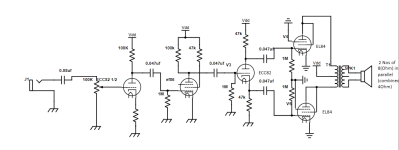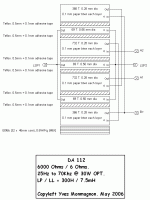Hello,
This is my second thread in this forum and my first thread was about the EZ80 rectifier. I am thankful to all members who helped us and we now have a working amp. See thread below.
https://www.diyaudio.com/community/threads/help-with-ez80-rectifier.403700/
We (myself and my son) are now building a new amp, an ambitious one, with two speakers. The circuit is attached. The problem is that none of the electronics shops are able to wind a EI output transformer for our specifications, Viz , Center tapped primary rated at 0-200V-0 and 25W and secondary at 0-12V at 25W. We are thinking of using two 8Ohm speakers in parallel (4Ohm in total). In the absence of a output transformer, what alternatives can we use?.
I'm tempted to buy some old tube radios at the weekly flea market and scavenge parts but i'm not sure if they would match specs.
This is my second thread in this forum and my first thread was about the EZ80 rectifier. I am thankful to all members who helped us and we now have a working amp. See thread below.
https://www.diyaudio.com/community/threads/help-with-ez80-rectifier.403700/
We (myself and my son) are now building a new amp, an ambitious one, with two speakers. The circuit is attached. The problem is that none of the electronics shops are able to wind a EI output transformer for our specifications, Viz , Center tapped primary rated at 0-200V-0 and 25W and secondary at 0-12V at 25W. We are thinking of using two 8Ohm speakers in parallel (4Ohm in total). In the absence of a output transformer, what alternatives can we use?.
I'm tempted to buy some old tube radios at the weekly flea market and scavenge parts but i'm not sure if they would match specs.
Attachments
Your "specification" for the OPT using voltages is completely incorrect. In fact I am not even sure where it could come from, perhaps you misunderstood information on repurposing toroidal power trannsformers as tube output transformers? Those winders could still be very capable of winding OPT's if you give them proper specifications.
A tube radio would be an unlikely source for an OPT that could handle PP EL84. You would have to find something capable of more power, such as a stereo of some kind, that used PP EL84 or PP 6V6.
A tube radio would be an unlikely source for an OPT that could handle PP EL84. You would have to find something capable of more power, such as a stereo of some kind, that used PP EL84 or PP 6V6.
Transformer spec is meaningless and the schematic is wrong.
Suggest you search a Classic PP EL 84 circuit .
Many excellent ones from the 60's, think Philips, Mullard, Telefunken, etc. Or even here in this Forum
Many books even offered details on how to wind transformers.
An experienced winder may probably have a suitable design in his bookshelf.
Just ask for a "15W EL84 push-pull OT"
Suggest you search a Classic PP EL 84 circuit .
Many excellent ones from the 60's, think Philips, Mullard, Telefunken, etc. Or even here in this Forum
Many books even offered details on how to wind transformers.
An experienced winder may probably have a suitable design in his bookshelf.
Just ask for a "15W EL84 push-pull OT"
It's conventional, therefor easier for others to understand, to specify output transformers (OPTs) as a primary impedance and secondary (load) impedance(s). For example, your push-pull pair of EL84 would conventionally be described as operating into an 8kOhm primary OPT and, in your use, a 4 Ohm secondary. Power rating can be nebulous, but 10 to 25 Watts is the right range.The circuit is attached. The problem is that none of the electronics shops are able to wind a EI output transformer for our specifications, Viz , Center tapped primary rated at 0-200V-0 and 25W and secondary at 0-12V at 25W.
The proposed schematic has multiple errors, so maybe the best plan for the immediate future is to choose an existing proven design, and work from there. Zillions of EL84 amplifiers have been made, and nobody complains about their results, so you have really good odds of being happy with your project when finished. Several other recent threads on this board have thrashed over different schematics' choices, but you won't go too far wrong with anything with push-pull EL84s. They're easy to get right, and not expensive, in the larger scheme of things. Maybe stick with something that isn't critically dependent on long loop feedback, which is fine, but not especially new-user-friendly. Maybe even begin with something with the output valves connected as triodes - this reduces performance demands on the OPT and might even allow removing any loop feedback, which makes success easier. At a loss of 3dB peak output, but might be a good trade-off for a next project.
All good fortune,
Chris
Last edited:
Thanks for your replies.
all the OT's are of only 100v primary, that's the problem.
Coming to the schematic, i can't spot whats really wrong. I have referred many push pull schematics before and this is the simplest i have spotted. An example is provided below. Am i going wrong in the amplifier section or the push pull section? Please correct my errors.

Just asking for a OT will not work here. people don't know what a el84 is. they need to be provided with everything, including the power, voltage, speaker etc.Transformer spec is meaningless and the schematic is wrong.
Suggest you search a Classic PP EL 84 circuit .
Many excellent ones from the 60's, think Philips, Mullard, Telefunken, etc. Or even here in this Forum
Many books even offered details on how to wind transformers.
An experienced winder may probably have a suitable design in his bookshelf.
Just ask for a "15W EL84 push-pull OT"
all the OT's are of only 100v primary, that's the problem.
Coming to the schematic, i can't spot whats really wrong. I have referred many push pull schematics before and this is the simplest i have spotted. An example is provided below. Am i going wrong in the amplifier section or the push pull section? Please correct my errors.
The only output transformers where the voltage is specified is the kind for speaker matching. https://www.premmagnetics.com/speaker-line-matching-transformers/ They will not work for your application.
Again, suggesting that commercial OPT's are only 100V primary is nonsense. I doubt anybody anywhere still makes an insulated wire with only 100V rating. You are probably discussing PA distribution transformers with 100V secondaries, again something that has nothing to do with tube OPT's.
You seem to be pursuing guitar amp circuits; if so, say that right away before you waste anybody's time critiquing your schematic.
You seem to be pursuing guitar amp circuits; if so, say that right away before you waste anybody's time critiquing your schematic.
Your first schematic had way too many errors, "correcting" means erasing it and starting from zero.Thanks for your replies.
Just asking for a OT will not work here. people don't know what a el84 is. they need to be provided with everything, including the power, voltage, speaker etc.
all the OT's are of only 100v primary, that's the problem.
Coming to the schematic, i can't spot whats really wrong. I have referred many push pull schematics before and this is the simplest i have spotted. An example is provided below. Am i going wrong in the amplifier section or the push pull section? Please correct my errors.
The second schematic is incomplete.
Search for EL84 schematics pulled from books , not random Internet sites, or this very Forum.
The transformer winding design shown above can be made by any competent winder.
As-shown it's nominally 6000 ohm to 6 ohm speaker, so 8000 ohm to 8.
For a 4 ohm secondary, change secondary turns to 49
Notice it's split into 3 secondaries which are then connected in parallel.
Please do not mention "Volts" any more when talking OTs, the proper parameter is "ohms".
- Home
- Amplifiers
- Tubes / Valves
- EI output transformer

